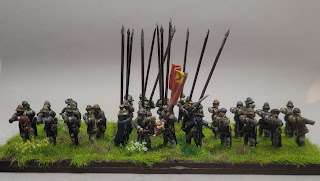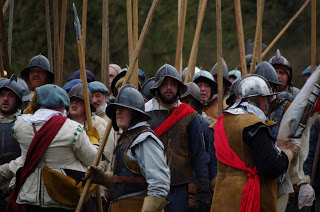Sir Phelim macShane Ó Néill's Regiment of Foot
I finally return to painting Irish Confederate regiments of foot: is the delay down to the fact I ordered the wrong figures, so now have to carefully cut away cast pikes and drill out hands; or, is it because I can't face researching regiments due to inconsistent spelling of names, and the fact that Irish gentry thought it would be a jolly wheeze to give every male in the family the same name?
And there's the start of my woes. Sir Phelim Ó Néill. 'Cheife Traytor of all Ireland'. Apparently. Known for his flamboyant colourful clothing that 'set off his red hair'.
Phelim, sometimes Felim, Phillom, Féilim; O'Neill, Ó Néill, sometimes O'Neil, Néill, and all combinations of the two.
I'll stick with Phelim macShane Ó Néill, if it doth offend thine eyes - sorry.
Phelim was born on 1604, eldest son of Turlough Ó Néill of the Kinard branch of the Ó Néills. (Which always brings to mind the "I work for Cunard" joke.)
He went to study law in London in the 1620s; whilst in London he briefly converted to Protestantism before returning to the Church of Rome. By the summer of 1641, he had been elected MP for Dungannon in County Tyrone.
The English policy of plantations, was causing widespread fear amongst the traditional Irish Catholic gentry, and things came to a head in 1641 when the English, aided by the Scottish Covenanters threatened to invade Ireland to finally subdue Catholicism. Sir Phelim joined the plot hatched by Ulster Catholics, to seize Dublin and then the other important towns of Ireland. Once holding these strategic towns, they planned to issue their demands for full rights for Catholics and Irish self-governance in the King's name.'Ó Néill's role was to take towns and fortified places in the north of the country.
The Regiment, unsurprisingly, was raised in 1641, and quickly saw action. Ó Néill, with 30 men took Mountjoy Fort, Salterstown and Charlemont. The full Regiment were present at the taking of Armagh; they were repulsed three times at Lisburn; were possibly involved in taking Strabane Castle; and possibly involved in a skirmish at Green Hills.
In 1642 they besieged Drogheda for five months before retiring to Armagh; they fought at Glenmaquin; part of the regiment garrisoned Strabane Castle, and were present when it was lost.
Sir Phelim would be sidelined, as a commander, after his disastrous defeat at Glenmaquin.
A detachment from the regiment would garrison Charlemont. The rest of the regiment would continue to fight at Clones, Portlester, Charlemont, Benburb and Scarrifholis, before finally surrendering in 1650 at Charlemont Fort.
After the surrender, Sir Phelim went into hiding rather than going into exile in France with his men. The Act for the Settlement of Ireland 1652 put a bounty of £100 on his head, as The Act named Sir Phelim as a ringleader of the Catholic uprising. He would be captured on the 4th February 1653 by William Caulfeild, 1st Viscount Charlemont on a crannog in Roughan Lough where he had taken refuge. He was taken to Dublin, where his trial was held. He was found guilty, hung, drawn, and quartered for treason on the 10th March 1653.
Lots of headswaps in this regiment, a handful of morions and cabascets. There is a predominance of PP 'Irish hats' and monmouth caps to represent Irish baraid.
The eagle -eyed amongst you will have spotted a Naismith halberdier, and a Steel Fist officer amongst the ranks of Peter Pig.
Clothing colours are based upon Sir J T Gilbert's (History of the Irish Confederation and the War In Ireland 1641-1643) description of the Confederates fighting at Kilrush being almost indistinguishable from the bog due to the dark colours they wore.
There is no known regimental colour for the regiment; however, a number of Irish Confederate flags are described, so I have randomly assigned one to the regiment.
 |
| Apologies, rubbish, slightly out of focus picture - I will replace it next time the photo apparatus is set up |
Custom casualty marker from Warbases. Flag, as always, from Maverick Models.
Update: since discovering the primary source material for the Catholic Confederacy flags (see here) I've reflagged the regiment. Here's what they look like now...


















A great start the the Confederates!
ReplyDeleteOn the home straight now - need to varnish and base another RoF, then it is just 2 RoF, 1 RoH, command, and baggage to go.
Delete